From the year 1754, the wilderness now known as Ranthambhore National Park (Hindi: रणथंभौर राष्ट्रीय उद्यान ), was maintained as the private hunting preserve of the Maharajas of Jaipur. In 1980 the Indian government declared the 392 km² area a National Park, dedicated to the protection of tigers. It is this former hunting ground that I chose as the place to try to get a Royal Bengal tiger in my sights.
I had been living in Singapore for less than 6 months. With a Christmas break approaching, I was looking for a week of adventure, within easy striking distance. Flights to Mumbai were cheap, and under five-and-a-half-hours, so I decided to head to India.
A wildlife enthusiast can not think of India without imagining dense, humid jungles where tigers lurk in shadows. Was it really possible to see a wild tiger, or were they too rare, or too well protected? Since childhood, I had dreamed of seeing tigers in the vast wetlands that form the Sunderbans, spanning Bangladesh and India, but with only 9 days leave from work, a trip deep into the Sunderbans did not appear to be manageable. However, a trip to Ranthambhore was possible in the time available, fell within budget and presented a real opportunity to see these, most majestic of cats.
Jaipur, the capital of Rajasthan, is a comfortable hour-and-three-quarters flight from Mumbai. Ground transportation is abundant, fun and cheap, by motorised rickshaw. Strike a deal with the driver before buzzing in to town to spend a night in one of Jaipur’s many hotels. The Pink City, with her truly magnificent architecture, enticing back streets and alluring antique shops is a great place to lose some time.
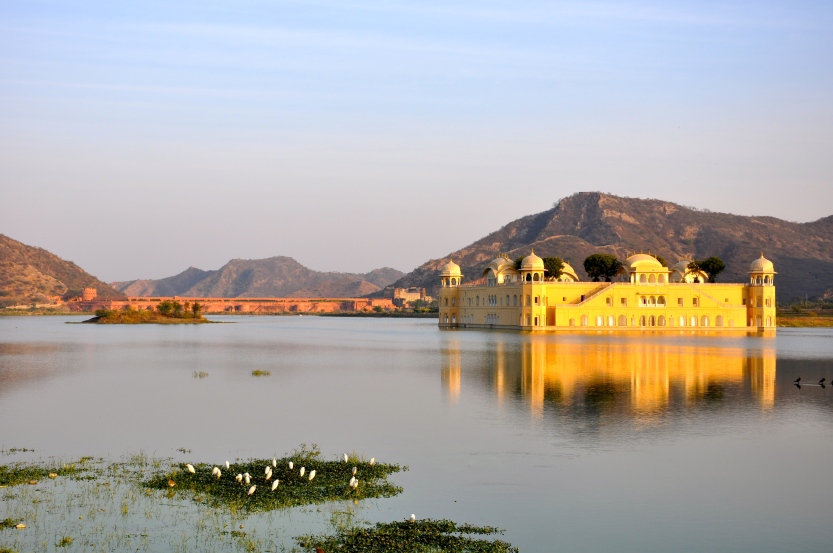
Transport can be easily organised to take you the approximately 140 km (87 miles) to Ranthambhore from Jaipur. There is a public rail option available but the comfortable and flexible option is a very reasonably priced private car with driver. This was my choice. The journey carves through the beautiful Rajasthan landscapes, where your senses are assaulted by vivid colours of flowing saris, the persuasive scent of spices and thirst quenching exotic fruits from roadside market stalls. Each bend in the road brings another impossible load being carried by trucks, cars, bikes, animals and people.
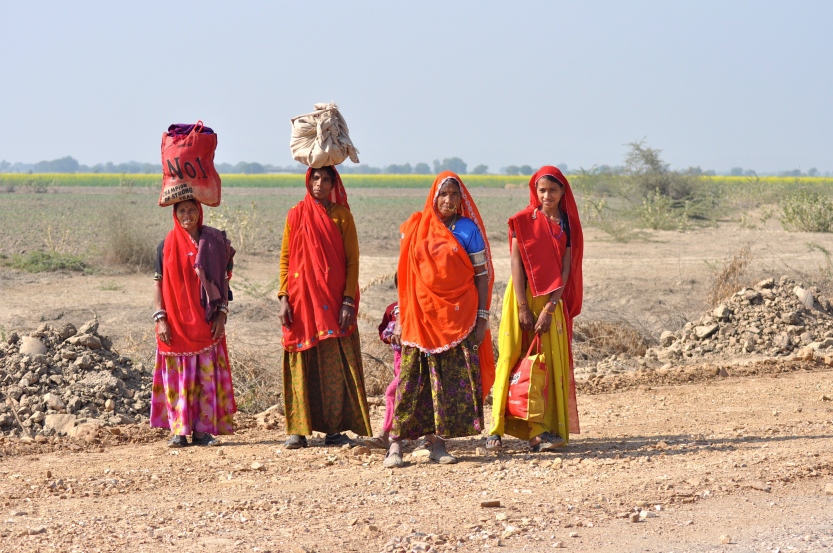
Ranthambhore is situated in the Sawai Madhopur district of southeastern Rajasthan, lying at the edge of a plateau, bounded to the north by the Banas River and to the south by the Chambal River. It is named after the historic Ranthambhore fortress, which lies within the park.
Tigers have become a major tourist attraction for this region, so accommodation is abundant and every hotel has the word “tiger” in its name. I highly recommend the excellent, Tiger Den Resort. It isn’t the cheapest stay in the area but it is clean, with good food and picturesque grounds. There are many cheaper options but in India, cheap is rarely the best option.
The park jeeps arrive early at the hotel to take guests on safari. The Rajasthan winter mornings make for a cold ride in open-top jeeps, until the spears of amber sunlight strike the clouds of fluorescent dust that hangs in the air.
The moment that you pass through the park gates you are transported to Kipling’s world where Mowgli swings and dances through The Jungle Book. The thick air, glittering with silver and amber dust, does not want to be breathed as it wraps you in a cloak of silence every time the jeep engine rumbles to a halt. Wildlife lurks in every shadow, from the birds in the bushes to the deer and wild pigs picking their way cautiously through the grass, while monkeys leap from branch to branch in the canopy above.
You feel the excitement vibrating through the small group of hopeful tiger hunters in the jeep, as every eye is trained on the shadows. The tension is palpable amongst the deer, which are ever-present. For us, the hunters, the sight of a tiger will bring the great joy of a once-in-a-lifetime experiences. For the deer, the sight of a tiger is likely to be an end-of-a-lifetime experience, which they are eager to avoid. While the deer feed, the monkeys keep watch. When the monkeys come to ground to forage, the birds keep a look out from the branches above. Every human and every creature in this park are searching for a glimpse of the elusive predator.

With the exception of gun wielding humans, Royal Bengal tigers are the top predator in India, with males measuring up to 3 meters (10 ft) in length, and weighing up to 300kg (650 lb). The female is slightly smaller than the male.
Such a prodigious beast should be easily sighted. I had fitted my camera with a 300mm zoom lens, but this was my first digital SLR and I had only had it for a couple of months. I had little idea of how to use it in the best of conditions, and had already found that the shadows, beams of sunlight and dust laden air would present a major challenge. My hands were griping the camera nervously, but in truth, I wanted to see a tiger; a photograph would just be a bonus.
“Tiger!” The call goes out from the front where our guide sat, “A female”. She is on my side of the jeep and all eyes turn left. I strain my eyes in to the shadows of the distant trees. Some people see it and there are gasps all around, but I still haven’t put my eyes on her yet. I feel panicked; what if it disappears into the bush and we don’t see another tiger? Am I about to miss my bucket-list moment because I can’t see the cat for the trees? My focal length begins to draw in its desperate reach and suddenly, she is there, filling my eyes, not in the distant bushes but just a few meters away, laying in the long grass with only her head and ears betraying her camouflage.

Now I gasp! I don’t know whether to take photographs our just gaze in wonderment. I decide on doing both. She regards us with the nonchalant ease of a creature accustomed to the peaceful apes in their mobile zoo cage, safe in the knowledge that without our guns, she could kill any of us with the swipe of a paw. A beam of sunlight cleaves the dusty air and she allows her weight to fall to the ground, rolling on to her back to bathe in the first shards of the morning sun. She spends, perhaps 10 minutes, rolling and rubbing her back on the dusty ground, like a house cat might on the garden deck on a spring morning.
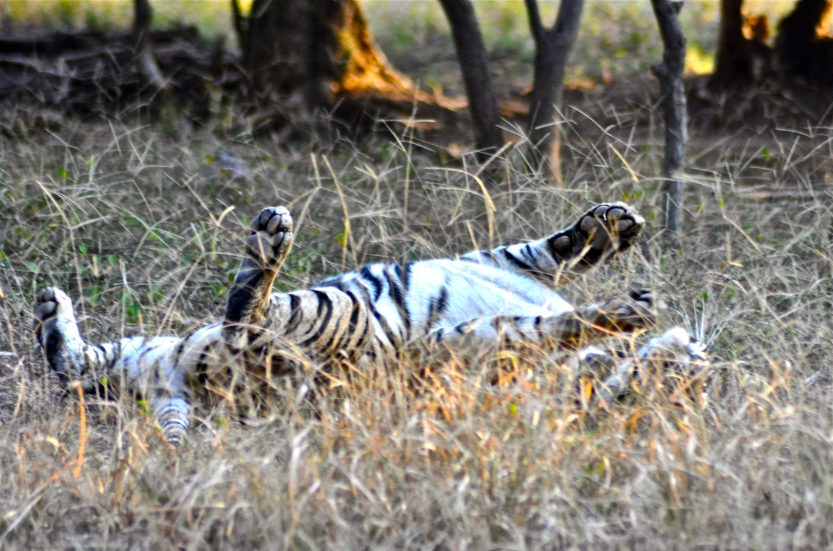
Now she is warm and relaxed, she stands up, revealing the full extent of her huge, athletic bulk. She rubs her chin on a nearby tree, confirming to intruders that this is her land. She pads forward silently but with purpose until she reaches a clearing where she stands still, focusing with keen intent beyond the trees ahead. Her ears are twitching and radar scanning as she stands tall, her tail lifts and curls. She is no longer that adorable kitten, rolling in the dust, now she is a hunter, a ruthless killer and she is going to kill her breakfast right now. She vanishes amongst the dark stripes of thin, dead branches and the orange hues of the tall grass. She was our only tiger sighting of the morning drive.
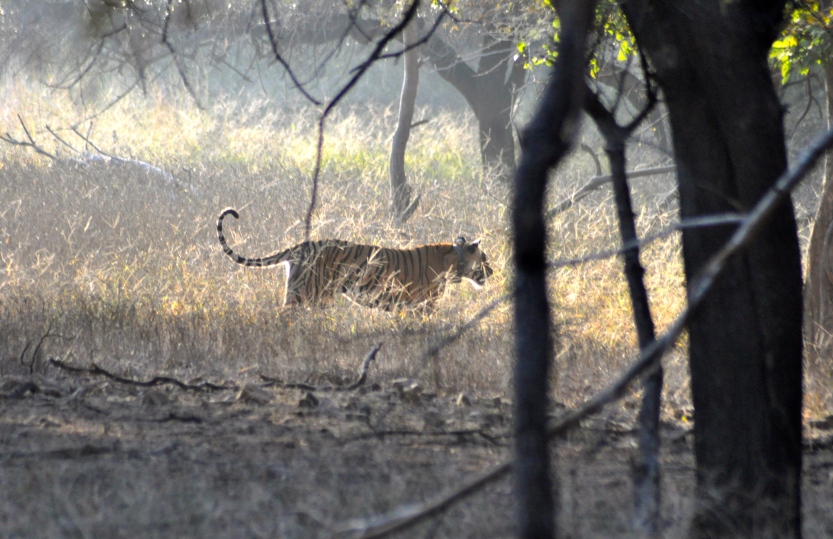
After lunch we headed back in to the park for the second drive of the day. The jeep was coming to the end of its afternoon tour. We were resigned to the fact that this would be a tiger free afternoon, despite the number of eyes on look out. The jeep took one last track along a high ridge, when an elderly Indian lady in the back let out a muffled croak. She croaked again, still quietly but more frantic and pointed to the long grass. The jeep stopped and the guide asked her what she saw. “There is a tiger, right there, in the grass, there, now!” Sure enough, just a few meters from the jeep sat a prodigious male tiger. We watched him for about 20 minutes before he stood up and hobbled in to the dense bushes. He had been injured, probably in a territorial dispute with another male tiger, but was still in fine condition.
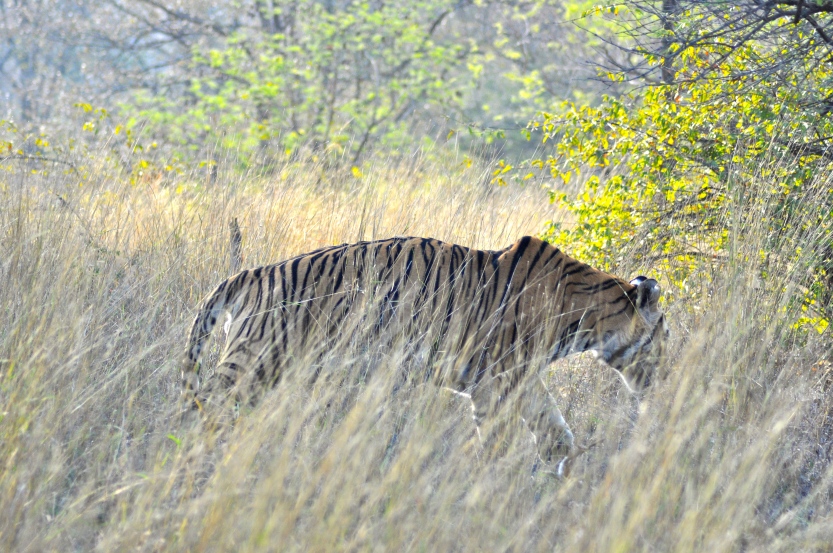
The following day passed without a tiger sighting. The excitement and searching eyes remained attentive all day but no tiger ears emerged from the long grass. A group of Indians from Mumbai were on a day-trip safari and chatted about how they had been 6 times without seeing a tiger. This was consistent with many other overheard conversations. Most visitors to the park never actually get to see a tiger. Their numbers are small and their camouflage is perfect for the environment. It was clear that seeing these creatures was a blessing not to be taken for granted. A trip booked to catch the end of the long dry season provides the best opportunity to see tigers as the cats can be found close to water.
A tigerless day at Ranthambhore does not mean a wasted day. The park remained alive with wildlife such as Black Buck, Sambar deer, Indian Wild boar, Chital (White-spotted deer), Nilgai (Blue Bull), Langurs, Macaques and a host of birds.
There is also the magnificent architecture of Ranthambhore Fort and the temples in and around the fort. These temples create another fascinating situation. During the drives through the park, where tiger roam and hunt freely, we often pass small groups of local people walking to the temples. A little internet research reveals that several people have been killed by tigers in the park, but this is not enough to discourage these people, who have lived with tigers all their lives, from making their daily pilgrimage.
The alarm clock signifies the start of the third and final day in Ranthambhore and the last chance to see another Royal Bengal tiger in the wild. With numbers diminishing at the current rate, perhaps this would be my last chance, ever.
The chilly morning drive started with a jeep of people wrapped in blankets for a little warmth until the sun gently warmed the earth. We drove until late morning, once again with no tiger success. The park closes for a few hours around lunch time to give the animals some much needed peace and quiet, and give the guests another helping of delicious dahl and rice.
The final drive arrives. With full bellies, we climb up with fingers crossed. I know that I have already been privileged but I would love just one more sighting to commit to memory. The dusty bone shaking ride had been taking us around the park for some time when we arrived at the lake. The cry of “tiger!” rang out and it was all eyes to the trees on a ridge, overlooking the lake.
There, sat with her broad, muscular back to us was Machali. This royal tigress is Ranthambhore National Park’s most famous resident. She is known as the Lady of the Lake, as she has been the dominant female over the coveted prime hunting spot around the lake for many years. She sat surveying her territory for a while, before lying down for an afternoon nap. We pulled away slowly so this aging lady would enjoy her siesta in peace.

We drove on for another hour, still excited but contented with our last tiger sighting, when once again the cry went up, “tiger!” for what proved to be my fourth and final tiger.
Out from the trees, came a beautiful tigress, shoulders rolling as she fixed us in her pale green gaze. Bold and confident, she circled the jeep and then stood alongside us. This was one of Machali’s daughters; a youthful adult, out for an evening stroll. She was stunning, and she knew it.
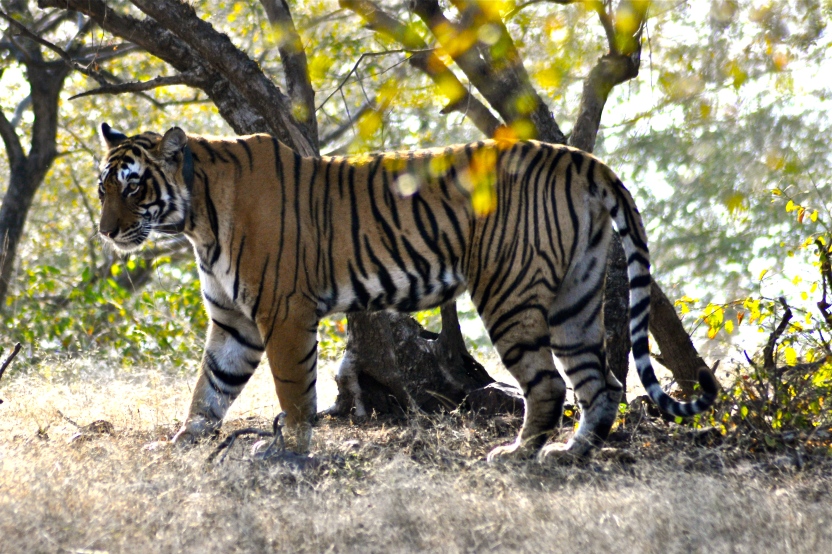
She started to walk alongside the road, happy for us to follow at low speed and even to trot alongside us with graceful ease, before cutting in front of the jeep and walking along the road. She stopped occasionally to scent mark her territory.
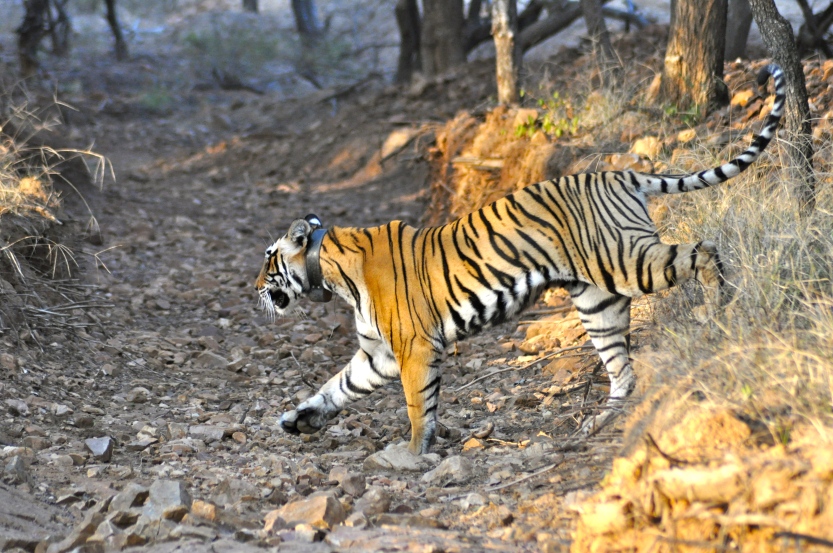
Another jeep joined us on the track; another group of fortunate men and women, who were connected by a shared realisation of a lifelong dream. Our female was happy to be photographed as she proudly stood between us. It crossed my mind that there was nothing preventing her from grabbing one of us in a suffocation hold and pulling us from the jeep. For her it would be like plucking grapes from the stem, but she had no interest in enjoying us for supper today.
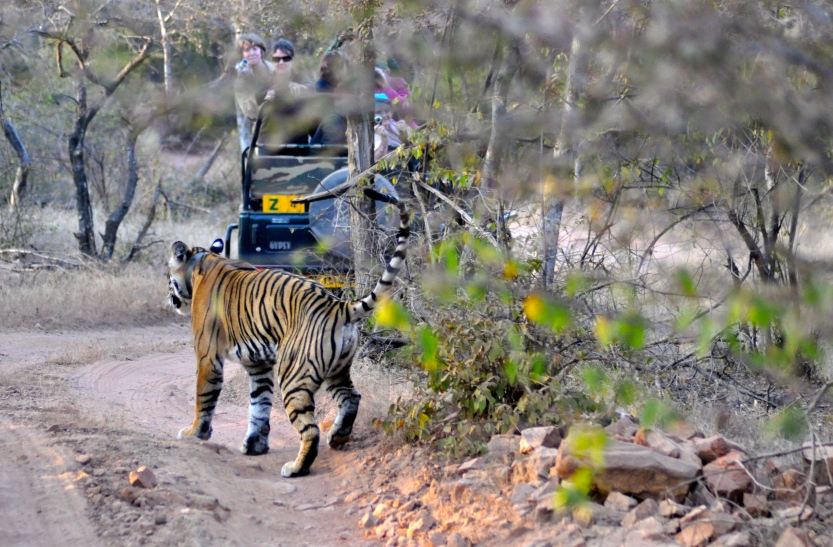
She turned towards the parched grass and without looking back, silently vanished in to the dancing shadows that paint stripes across the shimmering amber air.
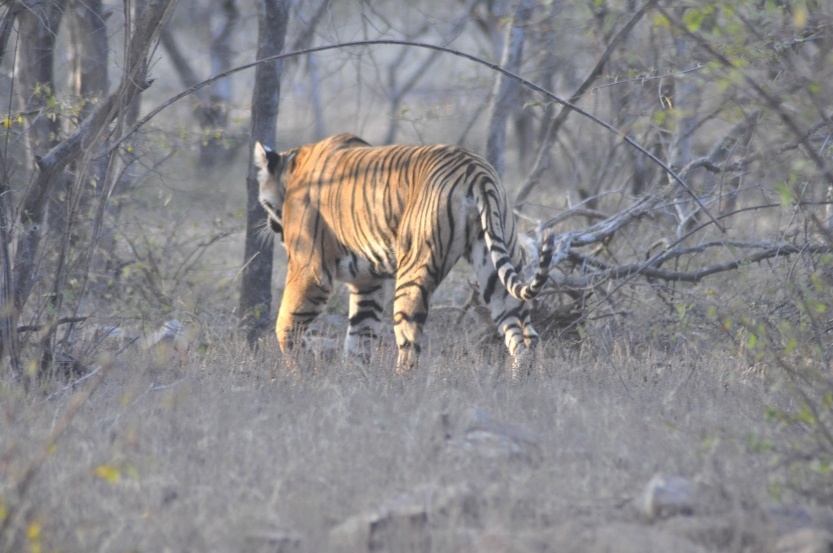
Numbers of wild Royal Bengal tigers are decreasing, with fewer than 2,500 individuals left. Loss of habitat and poaching continue to threaten the long-term existence of this precious creature. We can arrest this decline, if we preserve the last of the remaining tiger habitat. Responsible tiger related tourism, and the associated injection of cash in to extremely poor, local communities is one way of supporting the preservation of habitat, and all of the species within.
Checking off a wild tiger from your bucket list is a real possibility and can be done as part of a breathtaking, great value journey through Rajasthan, India. If you are looking for a trip to see one of the world’s great wildlife spectacles, whilst supporting conservation through communities, then this trip is for you.
If you enjoyed this post, please follow Incidental Naturalist.
Shares, comments below, and feedback welcomed
Categories: Asia
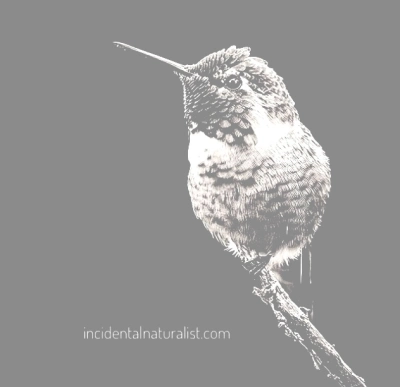




Love tigers! http://fineartamerica.com/featured/white-tiger-not-becca-lynn-weeks.html
LikeLiked by 1 person
Beautiful creatures and beautiful photographs of them, David. I remember the first time I saw a tiger in a zoo. I was amazed by their eyes and the size of their paws. Being somewhat uncoordinated, I admire their wonderfully slinky, fluid movements.
LikeLike
Thanks Jane! They are amazing creatures and very graceful, considering their size. It was certainly a special moment to see them in their natural habitat.
LikeLiked by 1 person
Magnificent photos, David. Were those photos taken by you?
LikeLike
Thank you, Tippi! Yes, I took these photos and all the other photos in this blog, so far.
LikeLiked by 1 person
Wow. The photos are incredible!!! This definitely sounds like a great bucket list item, so happy that you were able to see such a beautiful creature up close. 🙂
LikeLiked by 1 person
Thanks Krystle! It was certainly an incredible and emotional moment to see these awesome creatures, close-up and personal.
LikeLiked by 1 person
Lovely pictures. No tigers for me when I was in India but I will enjoy these.
LikeLike
Thanks Jane! Maybe you will see them the next time you find yourself in India 🙂
LikeLiked by 1 person
Tigers have been my favourite animals since I was a tiny little person. They are so beautiful and your photos capture their strength, grace and amazing colours. Well done! How lucky are you! 4 tigers! Were you buzzing?
LikeLiked by 1 person
Thanks Ruth, I was buzzing after the first one! It was amazing to see the other 3. It is such a beautiful place, too.
LikeLike
Wonderful post with great shots of these beautiful animals!
LikeLiked by 1 person
Thanks for the kind comment!
LikeLiked by 1 person
I quite liked the photos and your descriptions to go with them. Almost makes me feel like I am there… 🙂
LikeLiked by 1 person
As an Indian,I am proud to be here. Thanks a lot for lovely photographs…..Just Lens is not enough to catch the moment,But the sense must be there to capture it which you have immense…Thanks…
LikeLiked by 1 person
Thanks for the kind words! You are correct, A slightly larger lens would have made a difference for me.
LikeLike
Lovely blog. Thank you for the wonderful pictures too.
LikeLiked by 1 person
Wow, what an amazing story. I can’t believe you were able to see four of the world’s most endangered animals in one trip. I’m glad you had such incredible luck, and that you shared your experiences with us. Your images are stunning, and your writing is excellent. Thank you.
LikeLiked by 1 person
Thanks for that great feedback! You’re very kind. It was certainly an amazing experience and I was very fortunate to see any tigers, so to see four was extraordinary!
LikeLiked by 1 person
I’m jealous! Wonderful!
LikeLiked by 1 person
Loved this, really well written, and amazing photographs too 🙂 Even i visited the park early May 😀 Will write about it soon!
LikeLiked by 1 person
very descriptive !
and adventurous !
had fun reading it !
LikeLiked by 1 person
Lovely post. I love animals and tigers too!! The photos are incredible, I can’t believe you took them.
LikeLiked by 1 person
Thanks for the kind words! It is easy to take a nice photo with such a stunning model.
LikeLike
That’s true, I suppose all your photos have to be perfect for owning one of the best blogs!!😄
LikeLike
Thank you for those kind words!
LikeLike
Beautiful pictures. It sounds like you had an amazing journey, and I’m glad it was in support of these creatures. My only life encounters with tigers are in zoos unfortunately, which is to say we encountered a shell of an animal. Consider yourself lucky you got to see them in their natural element, where they deserve to be.
LikeLiked by 1 person
Thanks for the kind comment! I certainly consider myself fortunate to have experienced a tiger in its natural habitat. I hope that the tigers living in zoos around the world serve to inspire children to realise that we can protect wild habitats with nothing more than the authentic commitment of a few individuals.
LikeLike